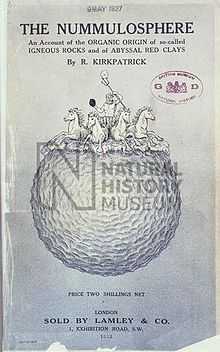Randolph Kirkpatrick


Randolph Kirkpatrick (1863 – 1950) was a British spongiologist, cnidariologist and bryozoologist. He was assistant keeper of lower invertebrates at the British Natural History Museum from 1886 until his retirement in 1927.
Kirkpatrick published a limited number of papers on the sponges of Antarctica and the Indian Ocean. However, his most significant work was carried out on Merlia, a species of coralline sponge (a sponge which secretes a coral-like limestone skeleton). He was the first to correctly interpret these unusual sponges, but his work was largely ignored until the 1960s when T. F. Goreau and his colleagues W. D. Hartman and Jeremy Jackson rediscovered the coralline sponges in the reefs of the West Indies.
It is likely that his important work on the coralline sponges was dismissed by his contemporaries due to his having published a book containing unconventional ideas about the history of life on earth. This was the self-published The Nummulosphere: an account of the Organic Origin of so-called Igneous Rocks and Abyssal Red Clays (1912), printed by Lamley & Co. of South Kensington. His book proposed the unusual theory that all rocks—literally all rocks—had been formed by the accumulation of forams such as nummulites.[1]
Kirkpatrick also identified and named the mollusc Pickworthia kirkpatricki Iredale, 1917 (now in the genus Sansonia Jousseaume, 1892).[2]
References
- ↑ Crazy Old Randolph Kirkpatrick by Stephen Jay Gould, Natural History 87(3), collected in The Panda's Thumb: More Reflections in Natural History (Norton, 1980)
- ↑ TMBL.gu.se, petymol.
External links
|